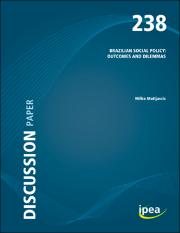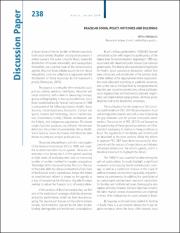Please use this identifier to cite or link to this item:
https://repositorio.ipea.gov.br/handle/11058/8895Files in This Item:
| File | Description | Size | Format | |
|---|---|---|---|---|
| DiscussionPaper_238.pdf | 1.66 MB | Adobe PDF |  View/Open | |
| DiscussionPaper_238_sumex.pdf | 143.59 kB | Adobe PDF |  View/Open |
| Title: | Brazilian social policy : outcomes and dilemmas |
| Other Titles: | Discussion Paper 238 : Brazilian social policy : outcomes and dilemmas Política social brasileira : resultados e dilemas |
| Authors: | Matijascic, Milko |
| Abstract: | Since redemocratization in 1985, Brazil’s system of social protection became more focused on the neediest while at the same time emphasizing universal access, especially focusing education and healthcare. In a traditional context of severe inequality, the sub-national units of government played a greater role in reaching the broader population with diverse social policies. Yet, Brazil’s social protection model favors cash transfers over social services, and reduces inequalities in the context of a highly unequal labor market. Strategies based on cash transfers policies appear to have reached their limits, because they are not the most effective way to promote equality and generate opportunities, when compared to the outcomes obtained by social service policies provision. Furthermore, while much progress toward reducing inequality has been achieved, benefits and services continue to fall short of what might be considered a welfare state. Poor administrative procedures, institutional problems and reduced efficiency are definitely major challenges to overcome in the Brazilian social policy scene. |
| metadata.dc.rights.holder: | Instituto de Pesquisa Econômica Aplicada (Ipea) |
| metadata.dc.rights.license: | Reproduction of this text and the data it contains is allowed as long as the source is cited. Reproductions for commercial purposes are prohibited. |
| metadata.dc.type: | Discussion Paper |
| Appears in Collections: | Desenvolvimento Social: Livros |
Items in DSpace are protected by copyright, with all rights reserved, unless otherwise indicated.

